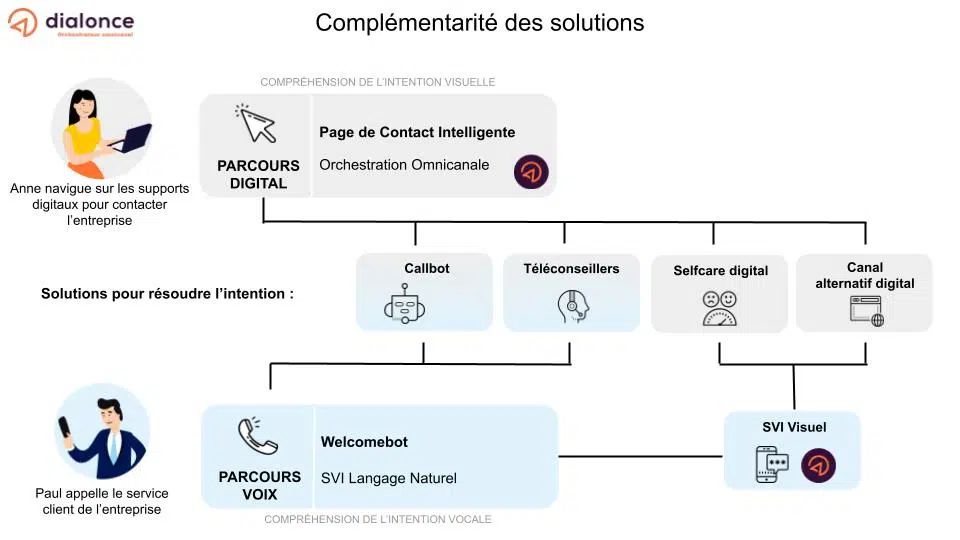Trends
< Back to the blog
Digitizing customer relationships has been a key challenge identified by companies for several years to grow and retain their customer base. It's essential to offer more services while preserving a simple and seamless experience; to do better for less while ensuring optimal service quality. COVID-19, as we know, significantly accelerated digital transformation, putting many companies against the wall: with very low dropout rates due to lockdowns, their customer services generated dissatisfaction and paved the way for players who had already undergone their digital transformation.
Customer direction is crucial. There is nothing more frustrating than being transferred from one department to another, from one advisor to another. To qualify the intention of an incoming call, a voice solution for intention qualification is needed: an Interactive Voice Response (IVR) system. We've all experienced the DTMF IVR and its famous "press 1 for..., press 2 for..." which allows for categorizing requests into broad categories, but it cannot be more detailed without risking the degradation of the customer experience.
Today, with Natural Language IVR, there theoretically are no limits to interpreting and qualifying the call's intention. This, of course, requires a significant technological investment so that the tool can understand the voice (noise constraints, accents, etc.) and interpret the need. It takes time and resources to refine the Natural Language IVR, and one must be willing to start with a potentially degraded understanding of intention.
Complementary to this voice journey, if we go back to the step preceding the call, it's also possible to propose a visual solution, on the contact page, where the customer service phone number is usually found. Instead of directly presenting the phone number and other contact solutions without having qualified the intention, the idea is to offer a digital journey that immediately refines the understanding of the contact reason (via questions or conversational interaction). This way, the customer's need can be directly oriented based on the added value of the reason and the company's processing capacity: for low-added-value reasons, towards self-care, a form, or a voicebot, and for high-value calls, towards human interaction via chat or a phone exchange with an advisor. This is referred to as omnichannel orchestration.
The visual component, with the smart contact page, allows for a finer qualification of the intent to contact and a wider orientation towards the appropriate solutions, whether they be vocal or digital. Meanwhile, for a simple, "processable" request through a vocal journey, the voicebot can provide a quick and efficient response. The shift towards a digital journey is made for more complex requests. Thus, the complementarity of the Visual IVR and the voicebot is linked to the nature of the need and the customer journey.
For example, for a moving request, it's quite straightforward to orally give one's name and new address to fill out a request form during an exchange with a voicebot. On the other hand, for booking an appointment, digital support is preferable: the customer can comfortably choose the time and place that suit them, rather than trying to respond to the voicebot while searching for the right slot in their calendar.
Another use case: you have a question about a bill and want to contact your customer service. Depending on the reason for contact (to consult? to pay? to dispute? to understand?), the voicebot will necessarily have to redirect the call towards a digital journey or towards a call advisor. However, the goal for organizations is to optimize both costs and customer experience, a dual challenge effectively met by the Visual IVR by limiting the handling of calls by call advisors to complex and/or specific cases (such as account opening, for example).

As we've understood, omnichannel orchestration through Visual IVR has the advantage of qualifying contact reasons upfront and sorting between those that are high value (where a call advisor's intervention is preferable) and those of lower value, which can thus be directed towards a digital self-care solution, an alternative channel (email, form, chat, etc.), or towards a callbot, which might be more suitable than a telephone call.
The Visual IVR, which allows for the redirection of a telephone call towards digital, also offers, beyond improving customer experience, the opportunity to capitalize on existing digital services and to promote them to callers. Indeed, visual customer journeys are currently more mature than vocal pathways and do not face the same oral comprehension limitations as Natural Language IVR, which is expected to improve in the coming years.
Nevertheless, with these two complementary solutions of omnichannel orchestration and Natural Language IVR, it's clear that customer relations have made a leap forward in the means it employs to optimize service quality while reducing costs. The time when companies accumulated contact channels at the risk of losing their customers in a multitude of choices (generating problems of reiteration and efficiency) is tending to disappear. It gives way to a management of the customer journey that is both more efficient and less costly, particularly welcome in these challenging times.